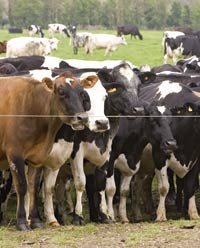Crossbreeding not the solution to poor health and welfare

Crossbreeding can often be seen as a solution to some of the health and welfare issues being tackled on a regular basis, such as fertility and mastitis.
But farmers considering crossbreeding need to think carefully about the choices they make and look at all the alternative options available before deciding if it is really the right approach, according to DairyCo breeding+ director Marco Winters.
“There’s no quick fix to any breeding issue, and crossbreeding is not for everyone. If it’s not done well it’s likely to complicate and exacerbate problems instead of solving them. It can also slow down herd improvements because the genetic information available for assisting crossbreeding decisions is nowhere near as comprehensive and reliable as what’s available for within breed improvements,” he says.
Mr Winters recommends looking at current within-breed tools available to tackle particular breeding issues, as the majority of problems can be addressed with the tools available, negating the need for crossbreeding.
“Tools are available to satisfy within breed requirements for genetic traits. These include Profitable Lifetime Index (£PLI), which includes direct measures of milk, fat, protein, lifespan, fertility and predictors for reducing lameness and mastitis – through locomotion and somatic cell counts,” he says.
DairyCo is part funding a research project titled “Expanding Indices”, which will expand the current portfolio of indices available with two new additional indices, one for calving ease and the second for direct udder health. The project also aims to improve on the current lifespan index.
“With these indices, breeders will be able to broaden their selection policy, reducing the cost of poor calving ease and improving further on udder health issues and increased longevity,” says Mr Winters.
For some time the £PLI has ranked traits according to economic value, and up until 2007 production traits had higher weightings than health and welfare. However, last year, the ratio was revised, with a ratio of 55:45 non-production to production.
“This goes some way to demonstrating in the past we have increased production at the expense of health and welfare, but now we’re making sure we continue to increase production and health, without compromising fitness,” he says.
DairyCo breeding+ is also working on a tool enabling farmers to adjust the relative weights of the traits under selection for themselves. So if they want to select a bull with good daughter fertility, then that can be given a higher level of importance than, for example, fat yield.
According to Mike Coffey of SAC, crossbreeding is something only those who are already making good and successful within-breed decisions should be considering.
“Moving into crossbreeding means keeping extensive records on the sire of each cow. It also requires farmers to keep a large inventory of semen as they have to have the right breed to hand at the point the cow is bulling.
“If farmers are prepared to invest the time and effort then there are rewards to be had, but it’s important we also concentrate on improving the breed we have now because without pure breeds there can be no crossbreeding,” says Dr Coffey.
DairyCo extension officer Andy Dodd agrees. “Farmers need to be sure of what they want to achieve when making breeding decisions. Whatever bulls are eventually used, it’s vital you use genetic data and only select the top bulls suiting your needs.
“Many farmers seem to make the choice to crossbreed to improve herd performance, but there’s little information out there to guide them and also a lack of information regarding sires and their breeding potential.
“Crossbreeding can be beneficial in helping to combine breed qualities such as yield, fertility and milk components, and when it is done well farmers can benefit from heterosis, or hybrid vigour,” he says.
With crossbreeding farmers need to consider potential problems, such as loss of pedigree status, TB valuations and surplus stock sales. However, despite published results about crossbreeding in other species, there is a limited amount of scientific evidence from UK farms to support any crossbreeding decision.
“DairyCo breeding+ is now developing genetic data, based on UK recorded data collected from milk recording organisations, that will make relative genetic comparison of bulls between breeds, as well as within breed, possible,” says Mr Winters.
